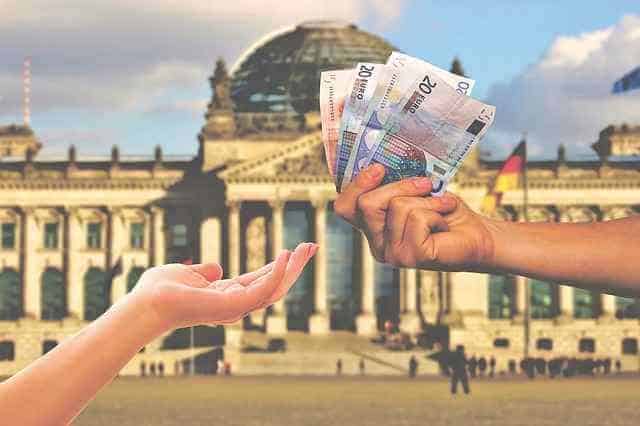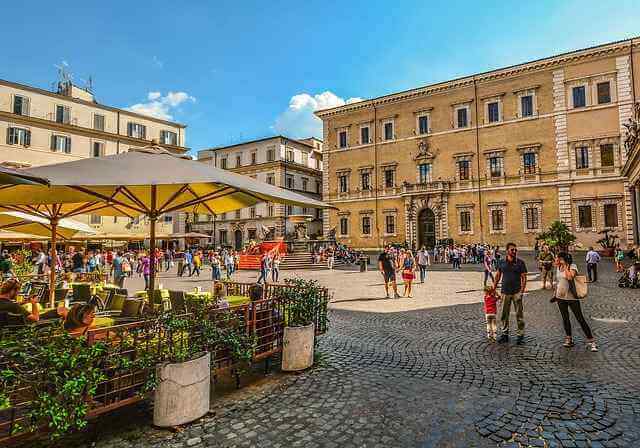Guide to St Peters Basilica in Rome. Use the Floor Plan & Guide to over 89 Attractions
Inside St Peters Basilica; Self Guided Tour: I
The floor plan further below of the inside of St Peters Basilica with map of items 1-89 listing the different statues, chapels and points of interest. The St Peters Basilica self guided tour leads you to the different areas to visit inside the basilica should take about 1 hour
History of St Peters Basilica: Old St Peters Basilica
The Circus of Nero was located in the area where St Peters Basilica and St Peters Square is currently located. Inside St Peters Basilica is the Tomb of St. Peter. In 40 AD, it was the entertainment venue for the Romans before the existence of coliseums. The Circus of Nero was a walled rectangular area bisected by a line of statues and columns called the Spina which separated the floor area into two halves. The Obelisk was transported from Egypt in 37 by Emperor Caligula, it marked the central point of the venue. The Circus of Nero was used for public presentations, performances and chariot races. In the time of Nero, the Circus of Nero was also used as the location of Christian persecutions and the site of Martyrdom. It is the location where St Peter was crucified upside down in 64 AD and buried in a cemetery nearby. Christians were blamed for the great fire of Rome in 64AD and St Peter was crucified on that false premise. Nero wanted a new palace for himself, his current palace, Domus Augustana, was located on Palatine Hill and he wanted to move his residence to the Roman Forum. There was no space in the Roman Forum for a palace, it is said that Nero caused the great fire to clear room in the Roman Forum.
After the fire, Nero went ahead with his plan and used the space created by the fire to build his new palace. However the Romans soon realized what he had done and blamed him for the fire. This eventually led to Nero’s downfall and his suicide. After Nero’s death, his new palace was torn down by his successor and the Roman Colosseum was built in its place. The Roman Colosseum was a free entertainment venue for the people of Rome, an appeasement for what Nero had done
In 326 AD, the Roman Emperor Constantine had embraced Christianity and allowed Christians to build places of worship. The Circus of Nero was torn down, St Peters Basilica was built in its place at the site of St Peters Crucifixion. Today this building is referred to as the Old St Peters Basilica. There are some remnants from the Old St Peters Basilica that were preserved included a few mosaics, and the old Solomonic Columns (from the Temple Solomon) which can be found in the new St Peters Basilica
History of St Peters Basilica: New Basilica
The Old St Peters Basilica eventually, like other older roman buildings, went into a state of disrepair with a potential to collapse as one of its walls was leaning six feet to one side. Eventually Pope Julius II commissioned the demolition of the Old Basilica and had the Vatican architect Bramante prepare designs for a new St Peters Basilica on the same site centered around St Peters tomb. St Peters tomb is in the Necropolis under the current Bernini’s Baldachin and Papal Altar inside St Peters Basilica, items 35 and 36 below
As part of the demolition of the Old St Peters Basilica, the original obelisk was moved from its original location to the new location were it still stands today. The new St Peters Basilica was completed in the time of Pope Paul III (Alessandro Farnese) and it was consecrated in 1626AD with design changes by Michelangelo. Michelangelo was 72 when he started work on the Dome inside St Peters Basilica, and not surprisingly, he died before completing the Dome (Cupola). It was finished by his pupil Giacomo della Porta
Alessandro Farnese became Pope Paul III, his family had vast property in Rome including the Farnese Gardens on Palatine Hill, The Piazza Farnese in Ancient Rome and Villa Farnese in Trastevere. Click on the links for self guided walking tours of the area
St Peters Basilica Entrance
St Peters Basilica is in St Peters Square. There is a long lineup to enter the area, the best option is to purchase a tour in advance, this allows you to skip the line . There are several options including tickets to climb St Peters Basilica Dome and / or the Underground Grottoes.
Inside St Peters Basilica and St Peters Square
General Information on how to how to skip the lines, best routes to take, how to enter St Peters Square, monuments inside St Peters Basilica, information desks, washrooms among others can be found in the HERE
General Information:
- You do not need tickets to go inside St Peters Basilica, it is free to enter, the entrances are listed HERE
- It is closed during Papal Audiences which happen on Wednesday mornings. St Peters Basilica opens around 1 pm on those days
- Liturgical or Papal audience tickets need to be ordered from the Prefect of the Pontifical Household,
- You can go to Confession located inside St Peters Basilica, see item 60 of self guided tour below
- St Peters Basilica Dress Code; there is a strictly enforced dress code for everybody: no shorts, no bare shoulders, dresses must be below the knee
- You will have to pass through security as you are entering a different country. All items will be scanned
- Visit the St Peters Basilica post office of this small country and send a post card home. Visit one of the three post office locations in St Peter’s Square
- Information desks are on the south wall of St Peters square or to your right as you enter St Peters Basilica; you will also find washrooms there
Tips for Monuments inside St Peters Basilica:
If you are short on time, you can modify the St Peters Basilica self guided tour and map and visit the highlights inside the basilica which include: The Holy Door, The Pieta, The Central Nave, The main Papal Altar and Baldacchini, The Dome (Cupola), St Peters Bronze statue, Pope John II Tomb, The Vatican Treasury and The Clementine Chapel located in the Grottoes below the Basilica (entrance from the Basilica)
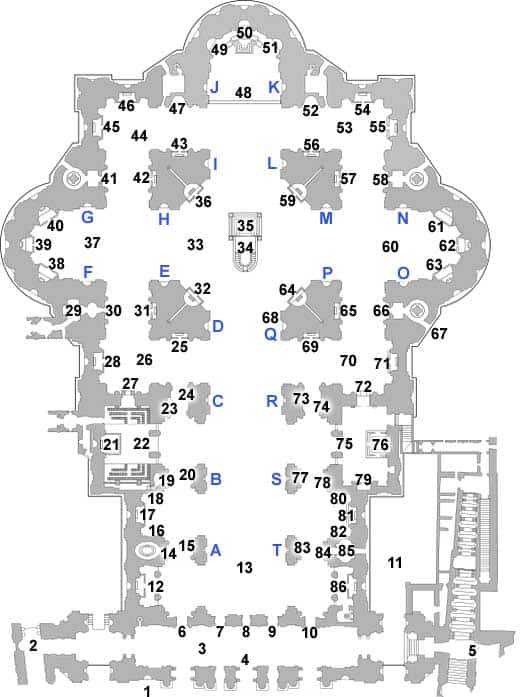
Inside St Peters Basilica; Self Guided Tour:
1. Facade
As you face St Peters Basilica, from left to right, the statues at the top are those of: the apostles designed in 1612-1613 for the Paul V Borghese, the seventh Pontiff
2. Charlemagne Equestrian Statue
The first Emperor to be crowned in St Peters Basilica on Christmas Eve 800. There is also a painting of the Coronation of Charlemagne by Raphael in the Raphael Room 4 (West Wall) of the Vatican Museum. On the floor in St Peters Basilica, you will also find a round red slab the Charlemagne kneeled on during his coronation
3. Portico (Atrium)
The Portico has five large doors that are entrances into the Basilica from St Peters Square. The ceiling is decorated with scenes from St Peters life and the lunettes (half moons) are statues of the 38 sainted popes
4. Giotto’s mosaic of the Navicella
Lunette of St Peter by artist Giotto (his paintings also hang in the Pinacoteca gallery in the Vatican museum). The scene depicts Jesus walking on water at the Sea of Tiberius; he is inviting Peter to have faith and do the same
5. Constantine Equestrian Statue in St Peters Basilica
Statue of Emperor Constantine sculpted by Bernini in 1670 and considered one of Benini’s masterpieces. Constantine is riding a horse and looking up with surprise at the apparition of a cross
6. Door of Death
To the left, before you enter inside St Peters Basilica, you will find the door of death. This door was used as an exit door during funeral processions, hence its name
7. Door of Good and Evil
This door was donated to Pope Paul V1 on his 80th birthday by the artist Luciano Minguzzi who worked on it for 7 years. The left side represents evil and the right side represents goodness.
8. Filarete Door
The artist known as Filarete made this imposing door in 1445. It is the oldest of the doors and was commissioned by Pope Eugene IV. It shows many scenes including the beheading of St Paul and the Crucifixion of St Peter
9. Door of the Sacraments
Completed in 1965 by Venanzio Crocetti, showing the seven sacraments: Baptism, Confirmation and Penance on the left panel and Eucharist, Marriage, Holy Orders and Anointing of the Sick on the right panel
10. Holy Door (Porta Santa)
Only to be opened during the Holy Year, known as the Jubilee which occurs every 25 years. Opened by the Pope on the first day of the Holy Year for pilgrims to pass through the door symbolize passing into the presence of God. It will be closed at the end of the Holy Year by the Pope. The last Jubilee was in 2000 held by John Paul II
11. Grottoes exit, Cupola kiosk
12. Baptism Chapel
Inside St Peters Basilica, is one of the most beautiful chapels and it is still in use on Sundays to administer the sacrament of baptism. The altarpiece is the baptism of Jesus by St John the Baptist in the River Jordan. Below this is a porphyry sarcophagus cover of the Roman Emperor Otto II (also known as Red Rufus) who died in 983
13. The Central Nave
Note the red porphyry disc inside St Peters Basilica. It is located on the floor at the center of St Peters Basilica entrance. This is the stone upon which Charlemagne and other Emperors were crowned (porphyry is a red igneous stone). On the south (left) wall of the Nave is an inscription that reads “I have prayed for you Peter, that your faith may never fail; and you in turn must strengthen your brothers” And on the North (right wall) the inscription is translated as “I will entrust to you the keys of the kingdom of heaven. Whatever you declare bound on earth shall be bound in heaven; and whatever you declare loosed on earth shall be loosed in heaven”
14. Monument to Maria Clem. Sobieski
Only one of three women in the basilica, she was the niece of the King of Poland and wife of James III (Stuart of Scotland). She died of tuberculosis at the age of 33 and was buried inside St Peters Basilica (there is an exit from the the roof)
Video of St Peters Cathedral and some of the monuments listed in this attractions guide
15. Monument to the Stuarts
Dedicated to James III and commissioned in 1819 by the British government, the monument marks the spot directly underneath where James III and his two sons were buried in the grotto. All three died in exile in Rome
16. Monument to Benedict XV
Pope Benedict XV; he is absorbed in prayer on a tomb commemorating the first world war that he made eight pronouncements against and declared it to be “degrading to mankind”
17. Presentation Chapel (Body of Pius X)
The virgin Mary is shown as a little girl climbing the stairs of the Temple with her parents. The altarpiece is called “Presentation of the Virgin Mary in the Temple”. Below the altarpiece is the crystal coffin with the body of St. Puis X
18. Monument to John XXIII
The bronze monument is the Church’s gratitude to a gentle Pope who was known as the “Good Pope”. The scene is that of Pope John XXIII (1958-1963) visiting the prisoners at a prison in Rome because they could not visit him. He was canonized along with Pope John Paul II on September 30, 2013
19. Monument to St. Pius X
The monument of St Pius X is carved out of white marble with his hands outstretch to the faithful. His father was a postman and his mother was a seamstress and he was known for the “holiness” which radiated from him. Hailed by the Italians as a saint, he was canonized 40 years after his death
20. Monument to Innocent VIII
Inside St Peters Basilica is the the oldest and the smallest monument, it was transferred from the Old Basilica. This monument depicts the pope who is seated and carrying the lance that pierced Jesus side. He is surrounded by the four cardinal virtues of Justice, Fortitude, Prudence and Temperance
21. Altar of the Immaculate Conception
This 15th century chapel dedicated to the Immaculate Virgin Mary and to St Francis Assisi (Sixtus IV) and to St Anthony of Padua is located inside St Peters Basilica. The altarpiece shows the Immaculate Virgin Mary surrounded by angels as well as St Francis, St Anthony and St John. The Column of the Immaculate Conception is located close to the Spanish Steps. Below the altarpiece are the remains of St John Chrysostom and relics of both St Francis and St Anthony
22 Chapel of the Choir
The name of the chapel is taken from the fact that the Liturgy of the Hours is celebrated here. Liturgy of the Hours are prayers, psalms and readings for each of the Hours. The books are thick with more than a thousand different Hours and using them is complex
23. Monument to Leo XI
Made of white marble. The inscription “Sic florui” refers to his short reign of 27 days in 1605. Pope Leo XI Medici is extending his hand toward his flock and surrounding him are the the Majesty of the Kingdom(left) and the Liberality(right)
24. Monument to Innocent XI
Surrounded by statues symbolizing the Christian virtues of Faith and Fortitude, the Pope is shown as victorious over the Turks. He aided the war against the Turk with prayer, diplomacy and huge financial aid to King of France leading to the lifting of the Turkish siege in Vienna in 1683
25. Altar of the Transfiguration
The altarpiece is a reproduction of Raphael’s Transfiguration that is in the Vatican Pinacoteca Gallery (Room 8) Museum. Six artists worked for nine years to complete the piece in 1767. Removed by Napoleon in 1797, it was returned to the Vatican in 1815. It shows Jesus in the light between Moses and Elijah while Peter, James and John kneel before him. Body of Innocent XI is located here
26. Clementine Chapel
It is named after Pope Clement VII for the Jubilee year 1600. The altar is dedicated to St Gregory; his remains are in a sarcophagus beneath the altar
27. Monument to Pius VII
The monument is part of The Clementine Chapel inside St Peters Basilica. He was put in prison by Napoleon and exile. When Napoleon was exiled and the Pope was free, the Pope did everything he could to help Napoleon and his Mother during Napoleons exile
28. Altar of St Gregory the Great
Dedicated to St Gregory, the altarpiece shows St Gregory the Great cutting the cloth from St Peters Tomb which had started to bleed. The sarcophagus contains the remains of St Gregory who adopted the title “servant of the servants of God. He was known as the “Savior of the Church”
29. Entrance to Sacristy & Treasury,
A list of 148 of the 264 deceased popes that are buried inside St Peters Basilica, (List of Popes buried in St Peter’s)
30. Monument to Pius VIII
He was imprisoned (as was his successor Pius VII) by Napoleon for refusing to take the oath of allegiance to Napoleon. The pope is kneeling below the statute of Christ with St Paul and St Peter below and on either side of him. The door below this monument is the entrance to Sacristy & Treasury (Item 29 above). You will find the mass schedule in front of this monument
31. Altar of the Falsehood
The altarpiece represents the story of the couple, Ananias and Sapphira, who kept money that was promised to the Apostles and for lying to St Peter. After lying to St Peter, Sapphira falls to the ground. In the backgraound two men are carrying her body to her husband Ananias
32. Statue of St Andrew
St Andrew was the brother of St Peter and the first disciple called by Christ. It is said that he was crucified on a cross in the shape of an X. The stairs leading you down to the Grottoes are found here
33. St Peters Basilica Dome
Michelangelo worked on the Dome inside St Peters Basilica until his death. At that time just the base of the Dome was completed. The Dome was completed by Giacomo della Porta in 1590. The cupola is supported by four massive five sided structural pillars and is 120m high. The dome rests on top of these pillars and the base of the dome are 16 big windows. From floor to ceiling the Dome is 448 ft high, and can fit the Statue of Liberty. The Latin text at the base of the Dome reads “You are Rock and on this rock I will build my Church, to you I give the keys of the kingdom of heaven”. You can find out how to climb the Dome HERE
34. Confessio (Tomb of St Peter)
Built from 1615-1617, it is located directly in front of the location of St Peter. St Peters tomb is said to in the necropolis which is below the floor of the basilica. The confessional area is a semicircular space at the same level as the grotto and can be accessed by a staircase
35. Papal Altar and Baldachin
The central altar, known as the Papal Altar is where Mass is celebrated; the tomb of St Peter lies is said to lie directly below. The canopy or Baldacchino surrounding the altar is 95ft and is a Bernini masterpiece and his first work in the basilica. He worked on it for nine years from 1624 – 1633 and used 100,000 pounds of metal
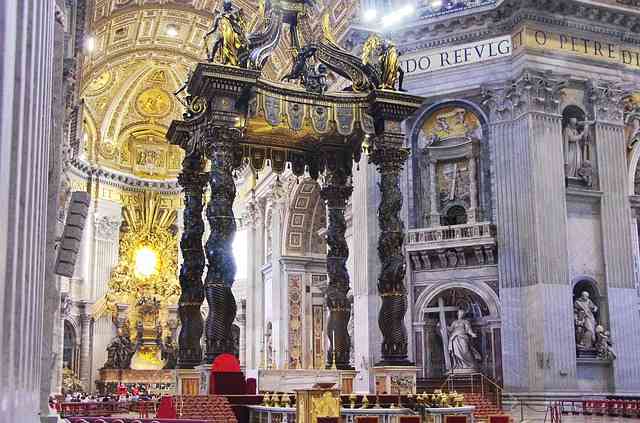
36. Statue of St Veronica
St Veronica wiped Jesus’s face when he fell under the weight of the cross, as he made his way to the Mount Cavalry where he was crucified. The veil that she is holding shows the imprint of a bearded man. The veil was brought to Rome from Jerusalem during the crusades. The actual veil is shown on the fifth Sunday of Lent in St Peters Basilica
37. Left Transept (daily mass)
The location of daily mass, the schedule is posted in front of the Sacristy (item 29)
38. Altar of the Crucifixion of St Peter
It is said that St Peter was crucified at this exact location. The altarpiece depicts the scene of crucifixion
39. Altar of St Joseph
The altar is dedicated to Joseph, husband of Mary. The sarcophagus beneath the altarpiece holds the remains of the apostles Jude Thaddeus and Simon
40. Altar of St Thomas the Apostle
The scene on the altarpiece is that of St Thomas titled “The incredulity of Thomas, representing his doubt in Christianity. This is where the saying Doubting Thomas comes from
41. Monument to Alexander VII
Another of Bernini’s masterpiece, it was the 80 year old’s last masterpiece. The pope is knelling in prayer surrounded by four statues of worship. Death represented by the bronze gilded skeleton holds an hour glass indicating time has passed while the pope deep in prayer is not disturbed by the appearance of Death
42. Altar of the Sacred Heart
The altarpiece is that of St Margaret Mary Alacoque who spread the devotion Our Lord’s Sacred Heart causing violent opposition. She was canonized by Pope Benedict XV
43. Altar of St Peter Healing a Cripple
The mosaic shows St Peter healing a man in Jerusalem at the temple gate “the Beautiful”. This biblical scene is from Acts 3:1-10. The cripple sat at the temple gates begging. Peter went to the temple with John and when the man asked for an alms, Peters said that he didn’t have gold or silver but could give him something better. “In the name of Jesus Christ, Walk”. He took the man by the arm who then stood up and walked
44. Chapel of Our Lady of the Column
There are two Altars in this Chapel, St Leo the Great and Our Lady of column
45. Altar of Our Lady of the Column
On the left is the Altar of Our lady of Column. Named after an image of the Virgin Mary that was found on a column in an old basilica
46. Altar of St Leo the Great
On the right as you enter you will find the Altar of St Leo the Great, the first pope to be buried inside St Peters Basilica. The altarpiece is that of the Pope meeting Attila the Hun and stopping his advance into Rome. A painting of this event is in Raphael Room 2 Hall Of Heliodorus in the Vatican Museum
47. Monument to Alexander VIII
It is noted for containing some of the richest rare and precious marble use to sculpt the statue of Alexander VIII depicting presentation of offerings to the pope during a canonization ceremony
48. The Tribune
Located at the apse of the central nave, is the Altar of the Chair of St Peter by Bernini. The chair is flanked by Paul III on the left and Urban VIII on the right
49. Monument to Paul III
The bronze statue of the pope is said to be surrounded by two statues; that of his sister Julia and that of his mother. They represent the virtues of Justice and Prudence
50. Cathedra Petri – Altar of the Chair
At the end of the central nave inside St Peters Basilica is the apse. A piece by Bernini to commemorate St Peter’s teaching in Rome. Every year the Church celebrated the feast of the Chair of St Peter. The sculpture gives prominence to the ancient wooden chair where the fragment of acacia wood are still visible. The statues are that of the Doctors of the Church; St Augustine (on the right), St Athanasius (on the left), St Ambrose and St John Chrysostom
51. Monument to Urban VIII
The pope that forced Galileo to recant, Urban VIII is seen to be giving a blessing. The statue on the left with some children is that of Charity. On the right is the statue of Justice with a sword and a scale. This is a typical pyramid style layout of sculptures that we have seen from Bernini
52. Monument to Clement X
The banner CLEMENS X / ALTERIVS ROMANVS / PONT. MAX. translated roughly as “Clement X, Supreme Roman Pontiff”. The tombstone below the monument contains the remains of Pope Sixtus IV and Pope Julius II as well as two cardinals
53. Chapel of Sts Michael and Petronilla
54. Altar of St Petronilla
Petronilla was the daughter of St Peter. She was martyred for refusing to marry a nobleman named Flaccus thereby sacrificing her virginity. She is traditionally known in France as the “eldest daughter of the Holy Mother Church”
55. Altar of St Michael the Archangel
Copy of an original mosaic of archangel St Michael. The original painting by Reni is in the Church of the Capuchin Order. This 1757 duplicate beautifully done by Cavalier d’Arpino capturing the original in perfect detail
56. Altar of St Peter raising Tabitha
The altarpiece shows the Resurrection of the Widow Tabitha of Jaffa by Peter
57. Altar of the Navicella
The mosaic shows the picture of Jesus walking on water. Peter had the faith to follow Jesus, however as his faith wavers, he started to sink
58. Monument to Clement XIII
Sculpture of the pope, with two lions at the base one awake and one asleep. It is said that the pope died suddenly at 75 due to the stress caused by the potential dissolution of the Jesuit order
59. Statue of St Helen
The mother of Emperor Constantine, she is said to have had a dream about the True Cross and was instrumental in bringing it to Rome. Her sarcophagus is in the Pio-Clementine Museum of the Vatican museum. Raphael’s painting depicting this moment in history is in the Raphael Rooms 1, Hall Of Constantine, in the Vatican Museum. The painting is on the east wall titled Vision of the Cross
60. Right Transept (Confession here)
This is only open to those who are receiving Confession; it is open when the church is open and available in several languages. Approach the attendant and let them know you want to to enter confession and specify the language. Generally open 7am to 12:30 and 4pm to 6pm, there are exceptions for Sundays and holidays
61. Altar of St Erasmus
A martyr under Emperor Diocletian. He was introduced to the pope in 1119 by St Peter
62. Altar of Sts Processus & Martinian
The prison wardens of St Peter who were converted were baptized and later imprisoned. The sarcophagus below houses their relics. The “Deliverance of St Peter” painting is found in the north wall, Room 2 of the Raphael Rooms in the Vatican Museum. The prison where St Peter was held is located in the Roman Forum and an altar dedicated to him is found in the basement of the building where he was held.
63. Altar of St Wenceslas
Dedicated to St Wenceslas who was both king and patron saint of Bohemia. His martyrdom was because of his conversion to the Christian faith and leading his people to conversion to the Christian faith
64. Statue of St Longinus
Longinus was the Roman soldier who pierced Christ on his side with a lance as he was dying on the cross. He experienced remorse after the death of Christ and converted to Christianity
65. Altar of St Basil
The mosaic altarpiece shows St Basil deep in prayer conducting mass; he does not waver even with the entrance of the pope
66. Monument to Benedict XIV
In the standard pyramid layout, you see the pope blessing his people while the statues of Wisdom (left) and Unselfishness(right) are below. The blessing act is said to be the Apostolic blessing
67. St Peters Basilica Dome Elevator (Cupola)
Elevator to the Dome
68. Bronze Statue of St Peter
The right toe of the statue is worn out due to the age old tradition of rubbing the toe for blessing/good luck
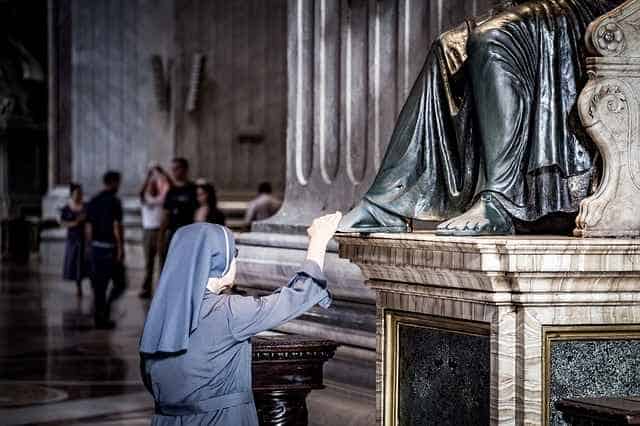
69. Altar of St Jerome (Body of John XXIII)
The 93-year saint is receiving communion on his deathbed with a lion at his feet and St Paul kissing his hand. The painting of St Jerome and the Lion is in Room 9 of the Pinacoteca gallery of the Vatican museum showing St Jerome removing a splinter from the lion’s paw
70. Gregorian Chapel
The chapel holds the tomb of Gregory XVI and Benedict XIV. There are three alters in the Chapel: Madonna of Succour, St Jerome and St Basil. It’s a lovely chapel decorated with marble, precious stones, gilded bronze nd mother of pearl
71. Altar of Our Lady of Succour
She is also known as Our Lady of Perpetual Help, granting prayer requests to those who were devoted to her
72. Monument to Gregory XVI
He was the last monk who was elected pope. The statue of the pope is surround by the statues of Prudence (the one with the snake) and Wisdom (with a crown of fire on her head)
73. Monument to Gregory XIV
One of the less elaborate monuments inside St Peters Basilica, he was pope for one year from 1590-1591. The statues of Religion and Justice surround him. The Popes arms are supported by angels. He did not receive a statue and was an unpopular pope for naming his family member as Secretary of State. The secretary of State then squandered the papal treasury
74. Monument to Gregory XIII
In typical pyramid layout, the popes statue is at the top with his arms outstretched in the act of giving a blessing. At this base are two statues, one of Religion holding the tablets representing Law and the other statue is that of Magnificence. The pope taught jurisprudence at the University of Bolgna before he was elected pope; he was an expert of both law and theology.
75. Chapel of the Blessed Sacrament
A silent Chapel for contemplation and reflection, it is not a part of the tour of St Peters Basilica. This section is reserved for those who want to pray. The Eucharist is performed in this chapel on a regular basis. The signage at the front of the Chapel says “Only those who wish to pray may enter”. The statue of Jesus is in the miniature dome with statues of the 12 Apostles on its cornice, the entire piece is surrounded by two angels. (for prayer only inside St Peters Basilica)
76. Altar of the Trinity
The mosaic behind the altar piece in the Chapel of the Blessed Sacrament shows the Trinity, The Father, The Son and The Holy Spirit. Unlike any other piece in the basilica, it is painted in canvas and not a mosaic. Refer to item 79
77. Monument to Matilda of Canossa
Statute of the Countess Matilda and two angels at her side with a sarcophagus below her. She supported Pope Gregory VII when Emperor Henry VII tried to take the pope hostage. The relief shows Henry IV on his knees waiting to be received by the pope for three days
78. Monument to Innocent XII
The statues of Charity and Justice (sword and scale) surround the pope. The pope is seated in the act of blessing and a woman with a small child is paying her respects. The pope was known for being charitable and humble towards the poor
79. Altar of St Francis
One of two altars in the Blessed Sacrament Chapel (item 75) inside St Peters Basilica. The portrait shows St Frances receiving the Stigmata (The bleeding from hands, feet and sides, the wounds of Christ on the cross)
80. Monument to Pius XII
He is portrayed in a stance and with an expression that shows his desire to end the Second World War as if repeating his famous saying “Nothing is lost in peace, all can be lost with war”
81. Chapel of St Sebastian (Body of John Paul II)
Pope John Paul II was the second longest serving pope at 27 years. He died in 2005, was beatified in 2011 and canonized in 2014. He was originally buried in the Grottoes below St Peters and his remains were moved to this alter in 2011 before he was beatified. The paining above depicts St Sebastian’s martyrdom under the Roman Emperor Diocletian who persecuted Christians. St Sebastian was thought to have the ability to ward of plagues and was known as the plague saint
82. Monument to Pius XI
He was the pope during the time that the Vatican received its independence from Italy under the Lateran Treaty on February 11, 1929. This made him the first head of state of Vatican City. He condemned Nazism as racist and anti-Christian in a letter smuggled into Nazi Germany and read at every German pulpit. In retaliation the Nazi’s intensified their persecution of the Church and its priests
83. Monument to Christina of Sweden
This monument inside St Peters Basilica is that of Queen Christina who abdicates from the throne and embraces Catholicism. The abdication documents are stored in the Vatican archives. She was ostracized by the Swedish aristocracy and made Rome her home until her death
84. Monument to Leo XII
Showing the 1825 Jubilee with the pope giving blessing. Note the hard to see statues of four cardinals behind the pope. Upon his election as a pope he made a note to the cardinals that they had elected “a dead man for a pope” as he was gravely ill. He was pope from 1823-1829. Beneath this monument is a door that leads to the closed door of St Nicholas Chapel which is thought to contain a wooden crucifix. The chapel is dedicated to St Nichols of Bari (Vatican City self guided tour, St. Nicholas Chapel)
85. Chapel of the Relics
86. Chapel of the Pieta
A must see chapel at the basilica. It houses one of the most famous religious sculptures, that of Mary holding Jesus after the crucifixion. The sculptor captures human suffering and the acceptance of sorrow and faith in Mary. An absolute masterpiece for the expression on Mary and Jesus who looks as if he could wake up from a tranquil sleep after his suffering. It was created by Michelangelo when he was 24 years old. He even signed the piece which is something he normally does not do. His signature is carved into Mary’s banner, as he heard rumors that his piece was being attributed to another artist
The statue was vandalized with a hammer in 1972 by a mentally disturbed man, he cracked off Mary’s nose and broke her arm at the elbow. It was painstakingly restored and placed behind a bullet proof glass to prevent any future damage
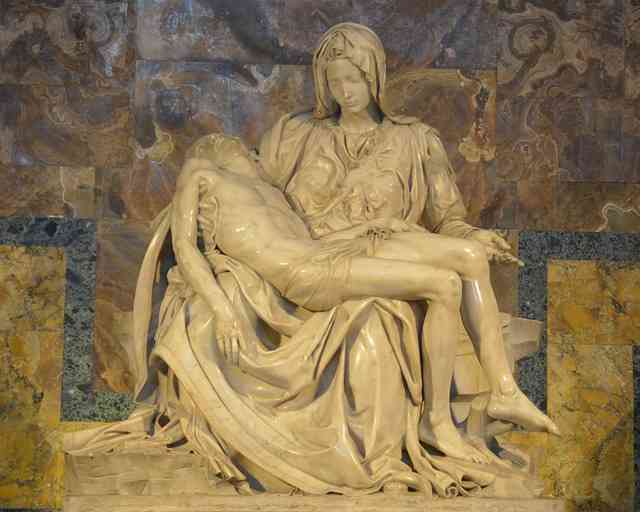
The 39 Saints who founded religious congregations (Inside St Peters Basilica are statue placement on the St Peters Basilica floor plan. The floor plan is located at the top of the page, items A-T):
A St. Peter of Alcantara (below) St.Lucy Filippini (above)
B St. Camillo de Lellis (b) St. Louis Grignion de Montfort (a)
C St. Ignatius of Loyola (b) St. Anthony Mary Zaccaria (a)
D St Francis of Paola St Peter Fourier
E St John of God (b) St Mary Euphrasia Pellettier (a)
F St Peter Nolasco (b) St Louise de Marillac (a)
G St Norbert (below) St William (above)
H St Juliana Falconieri (b) St Angela Merici (a)
I St Benedict (b) St Frances of Rome (a)
J St Francis of Assisi St Alphonsus of Liguori
K St Dominic (b) St Francis Caracciolo (a)
L St Elijah (b) St Francis de Sales (a)
M St Bruno (b) St Paul of the Cross (a)
N St Joseph Calasanctius (below) St Bonfilius Monaldi (above)
O St Jerome Emiliani (b) St Joan Antide Thouret (a)
P St Cajetan Thiene (b) St Frances Cabrini (a)
Q St John Bosco (above St Peter)
R St. Philip Neri (b) St. John Baptist de la Salle (a)
S St. Vincent de Paul (b) St. John Eudes (a)
T St. Teresa of Jesus (b) St. Madeleine Sophie Barat – (a)
Other Attractions in Italy
- Visit the Roman Colosseum. Click on the Roman Colosseum attractions map HERE and accompanying Colosseum attractions guide HERE
- Take the Rome attractions map and self guided tour: It includes the Vatican City attractions map HERE and the Vatican attractions guide HERE
- Self Guided Walking tour to explore the neighborhood of Trastevere with map of attractions HERE and guide of attractions HERE
- Visit St Peters Basilica. Explore all the attractions in St Peter’s Basilica with the attractions guide HERE
- One of my favorite places is the Roman Forum and Palatine Hill. The map of attractions is HERE and the self guided walking tour is HERE
- Self Guided Walking Tours – Day Trips from Rome
